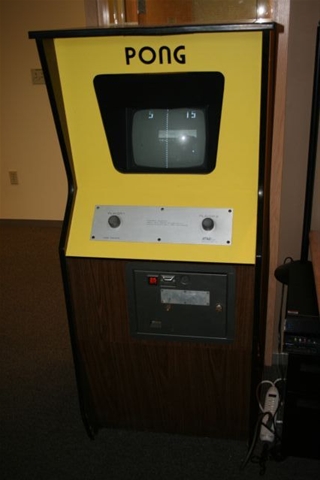"The 10 Most Influential Retro Games" is a feature series that will run daily for the next two weeks, between 12/3/12 to 12/14/12 on weekdays, with each day highlighting one of our ten picks in an unranked order. Follow our tagged page for Most Influential Retro Games to view the entire list. ~Ed. Nick
Do you remember your very first video game-related experience? If you're over 35 and started early, you might've had a Pong unit of some sort in your house. And if you've been playing games for any length of time and ever—ever—looked earlier than Super Mario Brothers, you might've even played the thing.
Back when playing games on a TV screen was little more than an accessory sold in Magnavox TV stores, Atari founder Nolan Bushnell was starting up a company to sell them. After supposedly playing the Odyssey prototype at the Consumer Electronics Show, new hire Al Alcorn was tasked with creating a basic game with a paddle, a ball, and a scoreboard. And damn, did he do a damn fine job, and in the process created the first successful arcade game.
Pong wasn't the first video arcade game, as Galaxy Game was played at Stanford and never mass-manufactured, while Computer Space was commercially available, both in 1971. But it was the first that a wide-spread audience really grabbed a hold of. First played by locals at Andy Capp's Tavern in Sunnyvale (near enough to Atari HQ), the basic back-and-forth tennis game debuted in 1972.
As the story goes, Alcorn was asked after a brief time to come in and fix the game; it had stopped taking quarters altogether. He rushed out and opened up the coin box only to find it filled completely. It wouldn't take quarters because it had no place to put them. After playing the machine themselves, that was the first moment that really cemented just how good a game Atari had in their hands.
After its release in arcades, Atari wanted to find a way to bring the experience home, and with some mechanical wrangling they released the stand-alone home console in 1975 (under the "Sears Tele-Game" moniker). It was a smash hit, eventually spawning sequels like Quadrapong and Pong Doubles to allow more players, but again, it should be made known that no matter the version, Pong wasn't even the first interactive video tennis game; Tennis For Two was a show piece for the Brookhaven National Laboratory in New York in 1958, and Magnavox's Odyssey console—the first official "video game console"—had a tennis game included in its release in 1972.
What made Atari stand alone was Pong, and what Pong created ended up being more than just a game. Nolan Bushnell's vision of taking this game—and the television game as a platform—was what made the game such a success. It wasn't marketed as a strictly niche product, but as a toy and game the entire family could play with. It was entirely different from any other game they could play. Monopoly had a significant amount of strategy and could lead to too much conflict. Clue was a cognitive specialty. Classic games like Chess and Checkers were entirely down to the quality of the player, where adults had a distinct advantage.
What Pong brought to games as a medium was balance: Everybody had the same controller, the same basic up or down (and English, or ball trajectory) movements. It was based entirely on reflex. Speaking as a kid who played games of this nature with adults, this was a more level playing ground than anything before it.
And more than that, after the successful launch of the industry, all kinds of other games exploded from the minds of young, talented programmers and designers. New genres were created, new worlds were opened to exploration—hell, it was almost as if Atari had recreated the film industry. They didn't bring video gaming to square one… they took it to step two. Pong is responsible for grabbing the world's attention in a way nothing had before and gave every other potential developer a new way to share a fun time. And that is why it's one of the most influential games in history.







